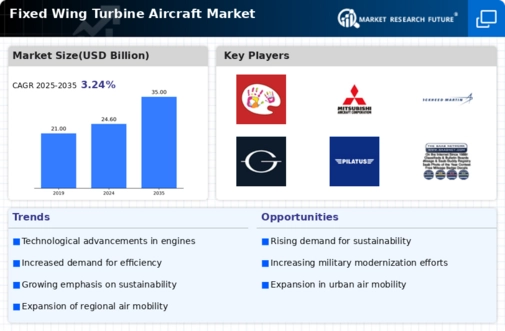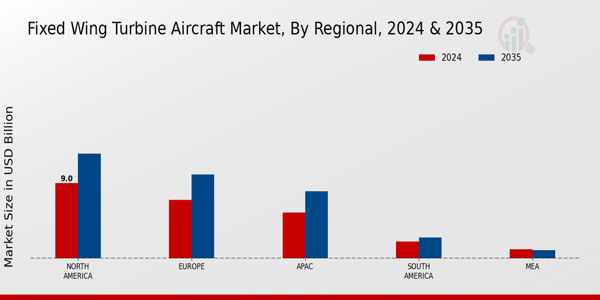Growth in Emerging Markets
The Fixed Wing Turbine Aircraft Market is poised for growth, particularly in emerging markets where economic development is driving increased air travel. Countries in Asia and Africa are experiencing rapid urbanization and rising disposable incomes, leading to a greater demand for air transportation. Recent projections indicate that air traffic in these regions could grow by over 6% annually, creating opportunities for turbine aircraft manufacturers. As infrastructure improves and more airports are developed, the accessibility of air travel is likely to expand, further stimulating demand for fixed wing turbine aircraft. This trend suggests that manufacturers may need to adapt their offerings to cater to the unique requirements of these emerging markets, potentially leading to a diversification of the product range.
Increased Demand for Business Aviation
The Fixed Wing Turbine Aircraft Market is witnessing a surge in demand for business aviation, driven by the growing need for efficient and flexible travel solutions. As corporations expand their operations and seek to optimize travel time, the appeal of turbine aircraft for business purposes becomes increasingly evident. Recent statistics suggest that the business aviation sector is expected to grow by approximately 5% annually, reflecting a robust appetite for private and corporate jet travel. This trend is further supported by the increasing number of high-net-worth individuals and the expansion of small to medium enterprises that require quick access to remote locations. Consequently, manufacturers are focusing on developing turbine aircraft that cater specifically to the needs of business travelers, thereby enhancing the overall market landscape.
Regulatory Support and Safety Standards
The Fixed Wing Turbine Aircraft Market is significantly influenced by regulatory support and evolving safety standards. Governments and aviation authorities are implementing stringent regulations to enhance safety and environmental performance in aviation. This regulatory framework encourages manufacturers to innovate and comply with new standards, which can lead to the development of more efficient turbine aircraft. For example, the introduction of new noise and emissions regulations is prompting manufacturers to invest in cleaner technologies. As a result, the market is likely to see an increase in the production of turbine aircraft that meet these enhanced safety and environmental criteria. This regulatory environment not only fosters innovation but also instills confidence among operators, potentially leading to increased demand for turbine aircraft.
Sustainability and Environmental Concerns
The Fixed Wing Turbine Aircraft Market is increasingly shaped by sustainability and environmental concerns. As awareness of climate change grows, there is a pressing need for the aviation sector to reduce its carbon footprint. This has led to a heightened focus on developing more fuel-efficient turbine aircraft and exploring alternative fuels. Recent studies indicate that the aviation industry aims to achieve net-zero carbon emissions by 2050, prompting manufacturers to innovate in sustainable aviation technologies. The demand for greener aircraft is likely to influence purchasing decisions, as operators seek to align with environmental goals. Consequently, the market may witness a shift towards turbine aircraft that incorporate sustainable practices, thereby enhancing their appeal in a competitive landscape.
Technological Advancements in Aircraft Design
The Fixed Wing Turbine Aircraft Market is experiencing a notable transformation due to rapid technological advancements in aircraft design. Innovations such as composite materials and advanced aerodynamics are enhancing fuel efficiency and performance. For instance, the introduction of fly-by-wire systems has improved aircraft handling and safety. According to recent data, the market for turbine aircraft is projected to grow at a compound annual growth rate of approximately 4.5% over the next five years, driven by these technological improvements. Furthermore, the integration of digital technologies, including predictive maintenance and real-time data analytics, is likely to optimize operational efficiency, thereby attracting more operators to invest in modern turbine aircraft. This trend indicates a shift towards more sophisticated and capable aircraft, which could redefine operational standards in the industry.


















Leave a Comment